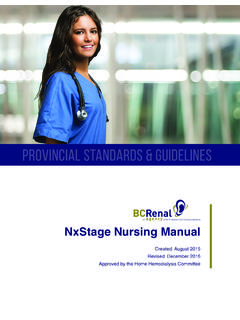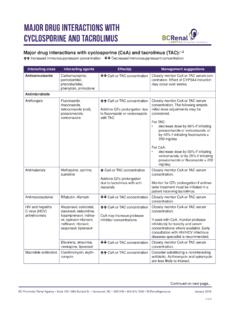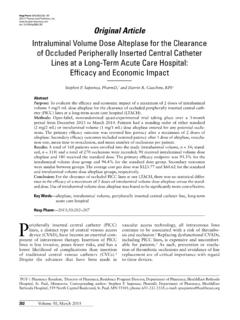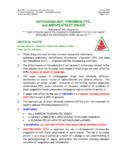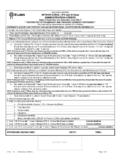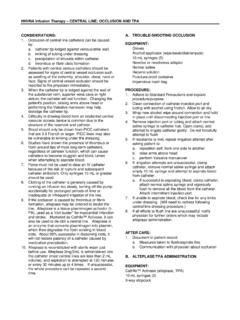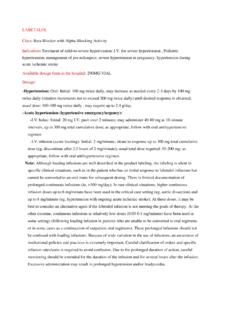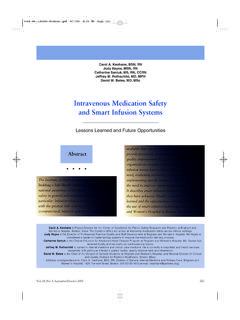Transcription of PROVINCIAL STANDARDS & GUIDELINES
1 alteplase Use for Occluded Hemodialysis CathetersMay 2017 Developed by the BCPRA Hemodialysis CommitteePROVINCIAL STANDARDS & GUIDELINESBC PROVINCIAL Renal Agency Suite 700-1380 Burrard St. Vancouver, BC V6Z 2H3 May 2017 Table of Scope of Guideline .. Summary of The Literature .. Recommendations & Rationale .. Algorithm to Guide Nurses in the Use of alteplase in Occluded HD CVCs .. Prescriber s Orders For alteplase Use For Occluded HD Catheters .. References .. Sponsors .. Effective Date .. Appendices ..11 Appendix 1: Prescriber s Orders for alteplase Use for Occluded HD Catheters (Sample).
2 12 Appendix 2: alteplase Use for Occluded CVCs (Sample Procedure) .. Practice Standard .. Definitions & Abbreviations .. Equipment .. Assessment & Interventions .. Documentation .. References ..19 Appendix 3: Summary of The Studies on the Use of alteplase in the Treatment of HD Catheter Thrombosis ..21 @BCRenalAgency PROVINCIAL Renal Agency (BCPRA)700-1380 Burrard StreetVancouver, BC V6Z 2H3 Phone: 604-875-7340 Email: INFORMATIONThis BCPRA guideline/resource was developed to support equitable, best practice care for patients with chronic kidney disease living in BC.
3 The guideline/resource promotes standardized practices and is intended to assist renal programs in providing care that is reflected in quality patient outcome measurements. Based on the best information available at the time of publication, this guideline/resource relies on evidence and avoids opinion-based statements where possible; refer to for the most recent version. For information about the use and referencing of BCPRA PROVINCIAL GUIDELINES /resources, refer to !3BC PROVINCIAL Renal Agency Suite 700-1380 Burrard St. Vancouver, BC V6Z 2H3 May 2017 This guideline is intended for adults and for children weighing over 10 kilograms.
4 For children weighing less than or equal to 10 kilograms, the concentration and dosage need to be Scope of GuidelineThis guideline provides recommendations for the use of thrombolytic alteplase (Cathflo ) to maintain catheter patency. A well functioning vascular access is a prerequisite for hemodialysis (HD). To be consistent with national and international STANDARDS , the BCPRA HD Committee has identified the preferred form of HD vascular access as the native arteriovenous fistula (AVF), followed by the artificial arteriovenous graft (AVG) and lastly the central venous catheter (CVC). Despite all best efforts for patients undergoing HD to have an AVF (preferred) or AVG (2nd choice), there will always be patients that receive HD by CVC on a temporary or permanent basis.
5 The most common complications of CVCs are thrombosis and infection (Develter, 2005 and Little, 2001). Even with care, fewer than half the CVCs placed as long-term accesses are in use a year after placement (Ponikvar, 2005) and about a third are removed because they fail to deliver adequate blood flow (K/DOQI 2006). The initial approach to treatment of a dysfunctional or blocked CVC is conservative rule out mechanical issues such as machine problems or kinks in the CVC and forcefully flush the lines with normal saline. If conservative measures fail, the administration of thrombolytic agents may be required.
6 Summary of the LiteratureUse of recombinant tissue plasminogen activators (rtPAs) ( alteplase , reteplase or tenecteplase)Mokrzycki and Lok (2010) reviewed the literature on the use of rtPAs ( alteplase , reteplase or tenecteplase) for the treatment of thrombosis in CVCs between 1993 and 2010. The short-term success rate ranged from 40% to 92% in the 18 studies reviewed. None of the trials compared the effects between the three different rtPAs. Mokrzycki and Lok stratified the 18 studies according to method of instillation: push/pause method, dwell (short and long-term) and/or infusion. They noted that: Methods of instillation were not compared in the studies.
7 Dwell time did not significantly impact short-term or 2-week patency rates in the two trials where this was studied (Nguyen, 2004 and MacRae, 2005). The success rate diminished with each subsequent dose of rtPA. Success rates by method of instillation alteplase Use for Occluded Hemodialysis Catheters4BC PROVINCIAL Renal Agency Suite 700-1380 Burrard St. Vancouver, BC V6Z 2H3 May 2017were as follows:Push/pause method (4 studies): Short-term: 59% to 92%. Long-term: 60% patency at 30 dwell (6 clinical trials; dwell time 60 min): Short-term: 69% to 97%; 22% to 97% if Tumlin s tenecteplase study (2010) is included.
8 Long-term: median time to next intervention: to 30 days. Long-dwell (7 studies; dwell time 2 to 72 hrs): Short-term: 79% to 100%; 22% to 100% if Tumlin s tenecteplase study (2010) is included. Long-term: median patency after rtPA was 14 to 30 (3 studies): Short-term: 84% to 91%. Long-term: 55% patency at 30 systematic review by Hilleman & Campbell (2011), on the safety and efficacy of alteplase , tenectaplase and reteplase for clearing HD CVCs included literature published between 1975 to 2010. The success rate was highest with reteplase (88 4%), followed by alteplase (81 37%) and tenecteplase (41 5%).
9 Use of AlteplaseAlteplase is used for CVC thrombosis in HD centres in BC. It is the only thrombolytic agent approved for CVC clearance and studies suggest a higher success rate with alteplase compared to tenectaplase. Reteplase is no longer available in is a summary of the results from 16 clinical trials on the use of alteplase for the treatment of thrombosis in CVCs:Success rates: Definitions of success differed between studies. Common definitions included: Short-term success: blood pump speeds of 250 to 300 mL/min and/or the ability to initiate HD. Long-term success: the time from the first course to the next course of alteplase treatment and/or CVC patency and/or survival.
10 Short-term success rates ranged from 59% to 100%. The time from the first course to the next course of alteplase ranged from to 30 days. Patency rates ranged from 54% to 60% at 30 of instillation: There was no obvious correlation between method of instillation and success. This finding was similar to that reported in two systematic review articles (Mokrzycki and Lok, 2010 and Lok, 2006). Dosages: For the push/pause and dwell methods, dosages ranged from 1 to 2 mg/lumen. There was no obvious correlation alteplase Use for Occluded Hemodialysis Catheters5BC PROVINCIAL Renal Agency Suite 700-1380 Burrard St.
